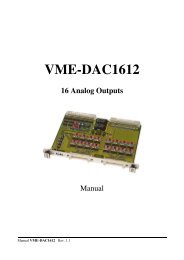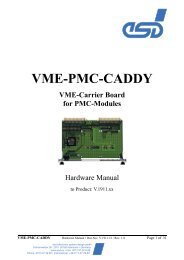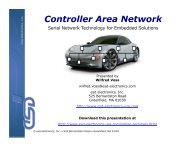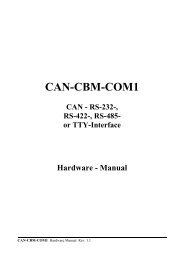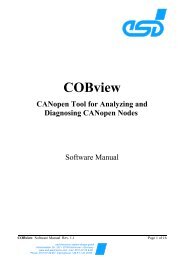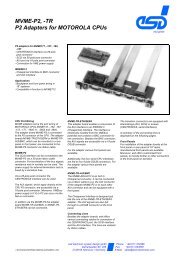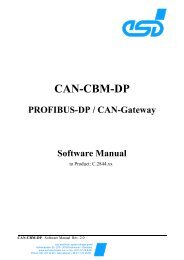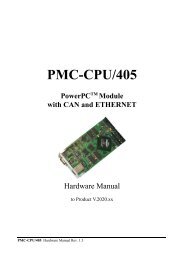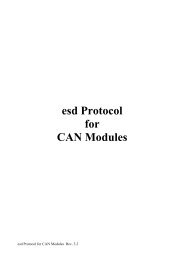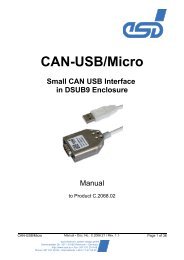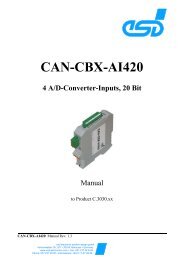Download complete software manual (PDF-File) - esd electronics, Inc.
Download complete software manual (PDF-File) - esd electronics, Inc.
Download complete software manual (PDF-File) - esd electronics, Inc.
Create successful ePaper yourself
Turn your PDF publications into a flip-book with our unique Google optimized e-Paper software.
Inhalt Seite<br />
1. Overview .................................................................... 3<br />
2. Entries for the Pin-I/O Operation (Setting and Reading Inputs or Outputs) ............ 5<br />
2.1 Selection and Assignment of Inputs and Outputs .............................. 5<br />
2.1.1 Pin-I/O Entries ................................................. 5<br />
2.1.2 Pin-I/O Outputs ................................................. 5<br />
2.2 Enabling Individual Outputs - SETDP1, SETDP2 ............................. 6<br />
2.3 Disabling Individual Outputs - RESDP1, RESDP2 ............................. 7<br />
2.4 Setting All Outputs - OUTDP1, OUTDP2 ................................... 8<br />
2.5 Reading the Error Status of the Outputs - ERRDP1 ............................ 9<br />
2.6 Reading the Inputs or the Actual Value of the Output -GETDP1, GETDP2 ......... 10<br />
3. Interrupt Handling .......................................................... 11<br />
3.1 Setting the Interrupt Modes of the CIO Z8536 Inputs - IRQDP1 ................. 11<br />
3.2 Assignment of EVENTs to the CIO Z8536 Inputs - EVTDP1 ................... 13<br />
3.3 Setting the Interrupt Mode of the HD63143 Pins - IRQUP1 ..................... 14<br />
3.4 Determining HD63143 Pins Which Triggered an Interrupt - IRSUPL, IRSUPH ..... 16<br />
3.5 Setting the Board-Interrupt Level on the VMEbus - LEVDP1 ................... 16<br />
4. Entries for the Pulse Processing Mode ........................................... 17<br />
4.1 Register Structure and I/O Pins ........................................... 17<br />
4.2 Resetting the HD63143 and Determining the Maximum Function No. -UPPINI ..... 18<br />
4.3 Pin Assignment and Operating Modes of the HD63143 -MODDPI ............... 20<br />
4.3.1 Selection of DPIO32 Board, of Pins and Edges ....................... 20<br />
4.3.2 Selection of the Pulse Processing Mode by Parameter mode ............. 25<br />
4.3.3 Pin-I/O Operation .............................................. 26<br />
4.3.4 NOP - no operation on pulse mode ................................. 27<br />
4.3.5 INC - increment counter, pulse Out ................................ 28<br />
4.3.6 FFC - fifty-fifty duty cycle counter with compare ..................... 30<br />
4.3.7 PWC - pulse width counter, reset by trigger pulse ..................... 32<br />
4.3.8 GTS - gated counter with sample .................................. 34<br />
4.3.9 UDS - up/down counter with sample ............................... 36<br />
4.3.10 TPC - two phase up-down counter ................................ 39<br />
4.3.11 FRS - free-running counter/timer with sampling ..................... 42<br />
4.3.12 INS - interval counter/timer with sampling ......................... 44<br />
4.3.13 FRC - free running counter/timer with compare ...................... 46<br />
4.3.14 OSC - one shot counter/timer with compare ......................... 48<br />
4.3.15 GTC - gated counter/timer with compare ........................... 50<br />
4.3.16 CTO - combination trigger one shot counter/timer .................... 52<br />
4.3.17 SIT - shift input ............................................... 54<br />
4.3.18 SOT - shift output ............................................. 56<br />
4.3.19 SPO - shift parallel output ....................................... 58<br />
4.4 Setting the HITACHI-Pulse Register -SUPDPI ............................... 63<br />
4.5 Reading the HITACHI-Pulse-Registers -GUPDPI ............................ 64<br />
VME DPIO32 Software Manual Rev. 2.1 1



